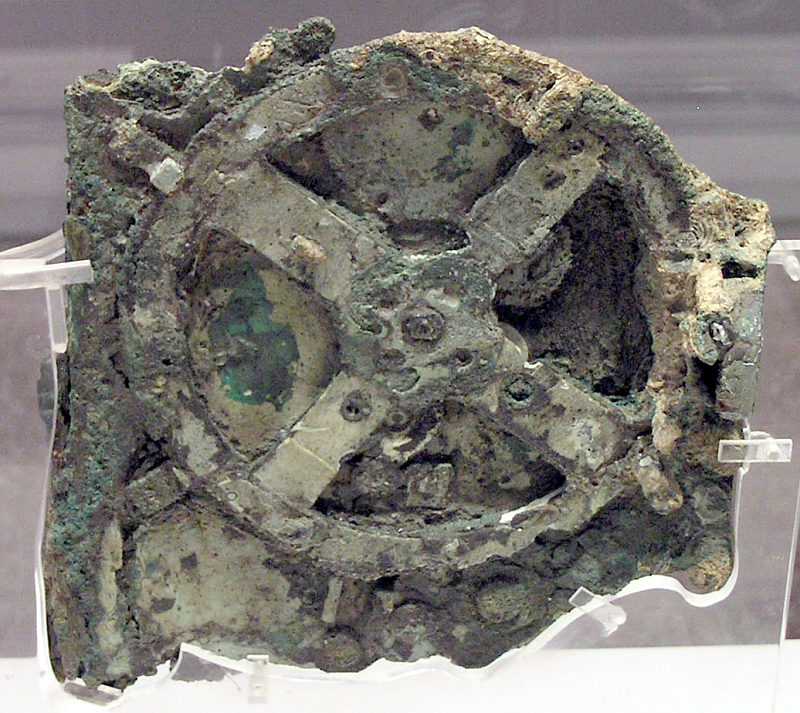In the Terminator movies machine intelligence is pitted against humanity. Cyborgs venture into the past to eliminate key humans to assure the machines’ ultimate mastery of the world. Is humanity destined to be eclipsed by the machinery it invents?
The ultimate expression of machine intelligence in popular science fiction is the intelligent robot, Data in Star Trek, or the many wonderful robots in Isaac Asimov’s 1950 collection of short stories, I Robot. These science fiction creations have their roots in history. As in all of my other discussions I like to begin in the past.
One of the first intelligent machines discovered early in 1901 CE but not understood at the time, is an artifact recovered from a shipwreck in the Mediterrannean Sea. Called the Antikythera Mechanism, a name derived from the geographic location where it was found, this machine dates aback to the 2nd century BCE. Described as the celestial super-computer of the ancient world, the Antikythera Mechanism is believed to have been inspired by the astronomer and mathematician, Hipparchos. It consists of a complex series of gearwheels that can predict the movments of the Sun and Moon over a Metonic cycle. If you are not familiar with the Metonic cycle, it is the 19-year period in which solar and lunar cycles align. The mechanism’s 31 hand-cut gearwheels are designed to track the solar year and the 235 lunar months required to complete a complete cycle showing accurate positioning of both Sun and phases of the Moon throughout the entire period.
The Antikythera Mechanism is only one of many ancient Egyptian, Persian, Greek and Roman intelligent machines using complex gear mechanisms. When the Roman Empire came to an end, its successors continued to build machines with complex gearwheel construction. One of these was the Zairja, an astrological forecasting device known throughout the Arab world. The Zairja was the inspiration for a 13th Century Catholic missionary, mystic and poet, Ramon Lull, who created the Ars Magna, a logic machine that consisted of a stack of concentric disks mounted on a central axis. Each disk rotated independently and was progressively larger from top to bottom. Made of card stock, wood, or metal, the disks featured written words and symbols that when rotated generated aligned text in the form of random statements.
The invention of the mechanical clock in the 15th century represented the next stage in machine intelligence and of course led to the development of the machine tool industry. The 16th century saw Gottfried Wilhelm von Leibniz invent the Step Reckoner mechanical calculator, the precursor to the adding machine and the first computer. Human induced machine evolution has continued to this day. But where is the science of self-replicating machines taking us?
The mathematician, John Von Neumann in the late 1940s first speculated in a series of lectures on what a robotic self-replicating system would look like. He proposed a detailed physical non-biological device that drew parts for assembly from a raw materials lying around. Von Neumann’s machine was programmed to retrieve the raw materials and assemble a duplicate of itself including its programming. Von Neumann’s ideas were popularized with the mid-1950s publication of an article in Scientific American where he described the characteristics of a self-replicating computing machine.
In 1979 NASA convened a New Directions Workshop at Woods Hole, Massachusetts in which the concept of self-replicating intelligent space probes was discussed. A working group proposed a feasibility study on using machines that could reproduce themselves from the energy and material resources already available in space. The idea was to take Von Neumann’s original concepts and translate them into actual engineering designs. NASA considered machines replicating solar cells from materials available on the Moon’s surface and then using the energy derived from the sunlight to generate self-replication of components and complete machines.
The development of nanotechnology materials, quantum and biological computing are bringing us closer to the reality of self-replicating machines. Some say that when we create the first intelligent self-replicating machine we will have created the last human invention. A self-replicating machine will contain biological characteristics, the ability to replicate at a molecular level in the same way that DNA and RNA replicate. An intelligent self-replicating machine will exploit nanotechnology. It will be capable of trial and error in its design evolution. Through this evolutionary process intelligent machines will create and discard design characteristics that fail their intended purpose. Darwin’s theories will be expressed through machine evolution.
In Part 4 we will talk about one of my favorite subjects, robots.

















Stephen Ornes writes in the September issue of Discover that robots called Lingodroids have been programmed to share language. The robots invent new words to describe experiences, places and plans and share these words with fellow robots. Janet Wiles, a cognitive scientist at University Queensland, heads up a team within the project. These rolling droids have cameras, laser range finders, sonar, miicrophones and a speaker. Their language is built from strings of beeps with each string corresponding to a letter in the alphabet. The robots roam thorugh a course and meet each other from time to time. When they find a place that is unfamiliar to them they give it a name adding it to their lexicon. Next step for these robots is to begin to speak to humans. Learn more by visiting: http://www.bbc.co.uk/news/technology-13510988.